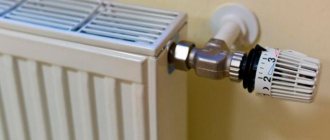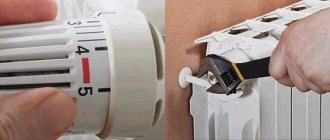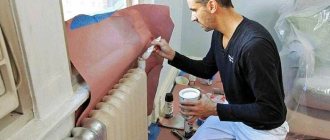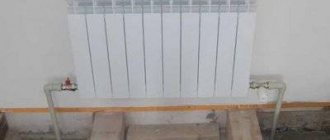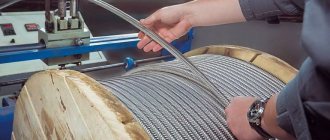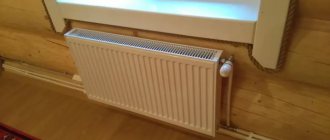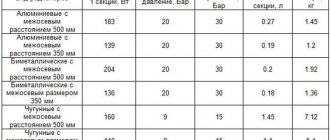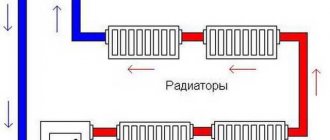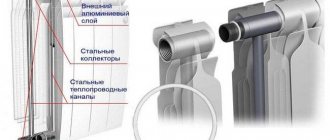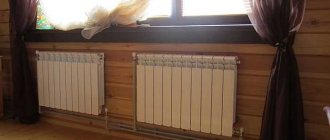For reliable and proper functioning of heating radiators, it is recommended to install special shut-off valves, which allow you to regulate the pressure and flow of the coolant, increasing or decreasing its volume. Heating efficiency very much depends on the correct choice of this technical equipment.
Currently, special ball valves for radiators are used to solve such problems. The tap is an indispensable part of any heating system, because they can, for example, completely turn off the heating in the summer or turn off the water to flush pipes and networks and regulate the temperature.
Cranes are installed to save energy and save money. Also, with the help of such simple devices you can get rid of air that may be present inside the pipes.
The need to adjust heat transfer
There are two reasons why heating radiators need to be adjusted:
- Reducing home heating costs. True, in an apartment located in a multi-storey building, it is possible to reduce the amount of payments only if there is a common building heat meter. In a private household, if an automated boiler is installed, installation of regulators is unlikely to be required. The amount of savings will be significant.
- There is a need to maintain the desired temperature in the premises. For example, in one room it may be 17 degrees Celsius, and in another – 25 degrees. To do this, you need to set the appropriate numbers on the thermal head or close the valve.
In this case, it does not matter how the heated coolant enters the radiators - centrally or autonomously. It also does not matter which heating unit is installed in the system. The fact is that the regulators on the batteries are not connected to the boilers - they function independently.
—
CONDITION 1
RESULTS ROOM ¸ÐºÐ°Ð¼Ð ¸ regurgitation ÑелÑкой. â
RESULTS ºÑÐ°Ð½Ñ ÑÑÑанавливаÑÑ Ñ Ð½Ð°Ð³ÑеваÑелÑнÑÑ Ð¿ÑибоÑоР²Ñи ÑÑем оÑоплениÑ; RESULTS ¾Ð´Ñ, поÑÑпаÑÑей в нагÑеваÑелÑнÑй п ÑибоÑ. â
| RESULTS. â |
RESEARCH, RESULTS ASSESSMENT I'm sorry. RESPONSIBILITY, RESPONSIBILITY ¿Ð¾Ð»Ð¾Ð¶ÐµÐ½ близко к ÑÑоÑÐºÑ Ð¸ Ñоеди → ´Ð¸Ð°Ð¼ÐµÑÑа, ÑÑо ÑаÑе вÑего вÑÑÑÑеÑаеÑÑÑÑ Ð¿°Ñи Ð¾Ð´Ð½Ð¾Ñ ÑÑбной Ñи ASSURANCE, ASSURANCE, CONTROL ±Ð¾Ñом и ÑÑоÑком ÑеÑез обÑаÑнÑÑ Ð¿Ð¾Ð´Ð²Ð¾Ð´ÐºÑ Ð¿ÑÐ ¾ RESULTS RESULTS , , , , , , , , , , , ²ÑаÑаеÑÑÑ Ð² ÑÑоÑк по ниР¶Ð½ÐµÐ¹ ÑаÑÑи подводки. â
Ðñ ° ðory ð´²²ð¹ð¹ð½^ ñ ñµices ”ðñ½ºð (ð¿ñuthently ( " registry ¾Ð±ÑаÑной) ÑоглаÑно пÑоекÑÑ. RESULTS RESULTS ¾Ð²ÐºÐ¸ пÑи RESULTS with the ÑоÑодР°. â
| RESULTS . â |
RESULTS RESULTS Ñ Ð ¿Ð¾ диамеÑÑам в ÑÑÑÐºÐ°Ñ Ñ Ð¿Ð¾Ð´Ñазделением на RESULTS. â
| RESULTS ÑлиÑовки ной ÑегÑлиÑовки. â |
RESULTS 100 Ð ¡. 100 rubles. â
| RESPONSIBILITY. â |
RESEARCH (No. 132, No.) A Ð¾Ð¿Ð»ÐµÐ½Ð¸Ñ . â
| ROSS-READY.| RESULTS. â |
RESULTS RESULTS Ñи гоÑÑÑей Ð²Ð¾Ð´Ñ Ð² нагÑеваÑелÑнÑе пÑибоÑÑ. â
RESULTS Ñ Ð´Ð»Ñ ÑиÑÑем Ð²Ð¾Ð´Ñ Ð½Ð¾Ð³Ð¾ оÑоплениÑ. â
RESULTS RESEARCH, RESEARCH, RESEARCH ¸Ð»Ð¾, подводÑÑей к нагÑеваÑелÑнÑм пÑибР¾Ñам ÑÑÑбе. RESULTS RESULTS ¾Ð²ÐºÐ¸ пÑи RESULTS Ñ ÑÑÑанавливÑÑÑÑÑ Ñ Ñ Ð¿Ð¾Ð»Ð½Ð¾ÑÑÑÑÑ Ð¾ÑкÑÑÑÑм ÑеÑение м пÑоÑоР´Ð°. â
Adjusting heating radiators
To understand the question of how to regulate heating batteries with a regulator, first of all, you should find out the principle of their operation. By design, the radiator consists of a labyrinth of pipes and fins of various types, which provide increased heat transfer.
Hot liquid enters the device, passes through the labyrinth and thereby heats the metal, which gives off heat to the surrounding air. The fins on modern radiators are made of a special shape, which improves the convection of air flows, and the room is heated quickly.
In the case of active heating from the batteries, a heat flow is felt. This means that when you change the amount of coolant passing through the device, you can adjust the room heating temperature, albeit within certain limits.
This is what special fittings are designed for - thermostats and valves. But a heating regulator installed on a radiator in an apartment is not capable of increasing heat transfer; it can only reduce it.
The effectiveness of changing battery temperature depends on:
- on whether the heating devices have power reserves;
- from the correct selection and installation of regulators.
Of no small importance is the inertia of the entire heating system and the batteries themselves. For example, cast iron, which has a large mass, changes temperature slowly, while aluminum heats up quickly and cools down the same way. This means that there is no point in having cast iron radiators with temperature control, since it takes a long time to get results.
Where to buy and cost
The market offers more than 50 types of battery valves. They can be purchased in almost any department of a hardware store related to equipment for equipping thermal systems in private or apartment buildings.
Also, battery taps can be purchased in an online store, knowing only the composition of the heating system. Considering all these tips, questions about where to buy radiator taps will simply not arise.
The price of radiator taps depends on the following factors: the manufacturer of the product, the region where these products are sold, the metal of the tap itself and its functionality.
Ways to increase the heat transfer of batteries
The presence/absence of the opportunity to increase heat transfer depends on the calculation of the radiator power reserve. If the device is not able to produce more thermal energy, then no fittings will help.
You can try to change the situation in one of the following ways:
- First of all, you should check whether the filters and pipes are clogged. Blockages form both in old buildings and in new buildings, as various construction debris enters the system. When cleaning does not produce results, drastic measures need to be taken.
- Increase in coolant temperature. This can be done if there is an autonomous heating supply, but with centralized heating it is unlikely.
- Changing the connection type. Not all battery connection methods are equally effective. For example, a reverse side connection reduces power by about a quarter. The location of installation of the device also affects the heat transfer.
- Increasing the number of sections. If the location and method of connecting radiators are chosen correctly, and the room is also cold, this means that the thermal power of the devices is not enough. Then it is necessary to increase the number of sections.
If the heating system is equipped with batteries with temperature control, then they require a certain power reserve and this is their main drawback. As a result, heating installation costs increase, since each section costs money.
Comfort cannot be achieved if the room is cold or too hot, so adjusting the heat in radiators is a universal solution to this problem.
There are many devices on sale that are designed to change the volume of coolant passing through the radiator. Among them there are both inexpensive and high-cost products. They come with different adjustments: manual, electronic and automatic.
Purpose. Characteristic
Taps ensure efficient operation of water pipes. The heating system cannot operate without these devices, and in some situations, using it without them becomes downright dangerous.
When the riser leaks, it is the shut-off valves that shut off the water, which makes it possible to make repairs without stopping the entire system
An important function will also be managing the heat dissipation of the battery.
The minimum set for the normal functioning of a conventional heating system consists of several types of shut-off and control valves. When connecting to the radiator, shut-off ball valves are mounted on the supply pipes, on the outlet and on the bypass. A mechanism is installed on the supply to adjust the coolant pressure. The radiator itself must be equipped with a Mayevsky tap. to bleed air. As you can see, the number of such products is significant and this is by no means an excessive option.
Taken together, this system allows:
- turn off the radiator without shutting off the entire circuit for repair, replacement, or maintenance;
- direct all coolant through the heater with the bypass turned off;
- control the pressure power through the radiator to reduce or increase the temperature;
- drain water, bleed air;
- protect the system from hydraulic shocks and breakdowns;
- regulate the efficiency and level of heat supply, which saves heating costs.
Requirements
The criteria for the variety of types of taps placed on heating radiators are: design, principle of operation and material
It is important to know that mechanisms of this type are divided into shut-off and control valves. What are the best taps to install? It must be taken into account that they have a rather complex structure and must meet a number of requirements in order to function in difficult conditions
- coolant temperature up to 200°C;
- must withstand pressure of 16–40 bar;
- high corrosion resistance;
- resistance to mechanical loads.
For heating systems, such mechanisms are made more stable. Conventional taps and valves for cold water cannot be installed in heating radiators.
Each connection has its own characteristics: there are regular and corner (for the bottom connection) taps. This division allows you to maximize the distribution of pipes when installing a heating system. The design features of the valves allow you to hide the pipes behind the decor, in a screed, or to mount radiators in a small space under a window opening.
In everyday life, the general name is used - “faucets”. But from a technical point of view it is correct to distinguish:
Heating systems also use thermostats; it is not recommended to use dampers or valves in radiators - they quickly become inoperable. If shut-off valves are needed, then ball valves are the best for this. They have only two positions - closed/open. Valves with a cone are designed to control the pressure manually. There are also mechanisms for automatic adjustment - these are thermostats with valves or cones.
Ball Valves
Valves are cheap, but at the same time ineffective control devices. Ball valves are often installed at the entrance to the radiator, with the help of which they regulate the flow of water.
But this equipment also has another functionality - shut-off valves. Valves are used to completely shut off the flow of coolant into the system. For example, in the event of a leak in a heating device, ball valves located at the inlet and outlet of the radiator allow repairs to be made without stopping the heat supply and draining the liquid.
Heating radiators in the apartment cannot be adjusted using ball valves. They have only two positions - completely closed and open. An intermediate position only brings harm.
The fact is that inside such a faucet there is a ball with a hole, which in its normal position is not in danger, but in all other situations the solid particles present in the coolant grind it down and pieces break off from it. As a result, the tap will not be sealed and in the “closed” position, water will continue to flow into the battery, which can lead to big troubles if the device leaks.
If one of the property owners decides to control the radiators using ball valves, you must remember that they should be installed correctly.
This method is usually used in apartment buildings. If the wiring is single-pipe vertical, then the hot water pipe enters the room through the ceiling and a radiator is connected to it (read: “Correct adjustment of heating radiators in an apartment - comfort in the home and saving money”). The pipeline departs from the second entrance to the device and is directed through the floor to the room below.
In this case, it is necessary to install the taps correctly, since the installation of a bypass is mandatory. The bypass pipe is needed so that when the liquid flow to the radiator is closed, the coolant continues to circulate in the general house system.
In some situations, the tap is placed on the bypass to change the amount of water passing through it and thereby adjust the heat transfer of the battery. To ensure greater reliability of the heating system, at least three valves are installed: two will be shut-off valves on the radiator and function normally, and the third will become a regulating valve.
But here we must not forget what position the devices are in. Otherwise, you can completely block the riser and you will not be able to avoid the cold in the apartment, as well as unpleasant showdowns with neighbors and representatives of the management company.
Therefore, when deciding how to regulate heat in batteries, experts do not recommend using ball valves. There are other products on the market that are specifically designed to change the amount of water circulating through the radiator.
Types of locking elements
Any check valve (the outdated name is non-return) performs a simple task - it does not allow the coolant flow to change direction, passing liquid only in one direction. In water heating schemes, this function is not always needed and is implemented as needed.
The following types of check valves are used in heating systems of private houses and apartments:
- petal;
- disc-shaped;
- ball
Industrial models are installed in large boiler houses and production facilities
Let us analyze the device and operating principle of each type of valve separately. In the future, this will help you understand which product is best to select and install in a specific heating system.
Reed valves
The element, made of brass or stainless steel, consists of the following parts:
- body in the form of a tee with a unscrewing top plug (for maintenance);
- a butterfly valve mounted on an axis by means of a rotary lever;
- a seat with a seal into which the disc fits when closed.
The general design of a reed check valve is shown in the detailed drawing. The principle of operation of the element is as follows: the coolant moving in the indicated direction deflects the locking disc and freely passes further along the pipe. When the direction of water flow is reversed, the valve, under the influence of gravity (or a spring), automatically slams shut and blocks the passage.
Typical gravity seal design
We list the important characteristics of petal check valves installed in heating systems of private houses:
- internal passage diameter – from 15 to 50 mm (½—2 inches);
- maximum working pressure – 16 Bar;
- low hydraulic resistance;
- There is a screw on the side of the body for disassembling and adjusting the shutter axis;
- The gravity version without spring can only work normally in a horizontal position.
The design and operating principle of the rotary valve is shown in detail in the video:
Poppet valves
The principle of operation of a poppet check valve is clear from its design, shown in the drawing:
- Inside the cylindrical brass body there is a platform with a round hole - a saddle.
- On the other side of the part there is a partition with a hole in the center.
- A rod with a disc-type valve at the end equipped with a seal is inserted into the hole in the partition.
- A spring is installed between the partition and the “plate”, pressing the disk to the seat.
Water flowing in the right direction overcomes the elastic force of the spring, opens the valve and moves on. Flow in the opposite direction is impossible - the duct instantly closes. What properties of a check valve are important for heating systems:
- ability to function in any orientation of the body in space;
- working pressure – not less than 10 Bar, diameters DN15 – DN100 (internal);
- type of connection – coupling (internal pipe thread);
- spring lock creates increased hydraulic resistance to fluid flow;
- The seal loses its tightness if solid particles, such as sand, enter.
In the utility networks of private houses and apartments, valves with coupling connections are used
Disc locks are also used in water supply networks, for example, in conjunction with submersible pumps. The valve prevents water from the pipelines from flowing back into the well or borehole.
Ball valves
This is a check valve of the simplest design, operating on the following principle:
- Inside the cylindrical brass body there is a ball made of rubber, less often aluminum.
- The ball is prevented from jumping out by 2 partitions with holes made along the edges.
- The coolant flow presses the rubber ball against the partition with ribs. These protrusions form a gap where water flows freely.
- If the coolant moves in the opposite direction, the ball will press against the second jumper - the seat. Since there are no ribs, the body of the ball will completely cover the passage hole.
The advantages of a ball check valve are low price, low hydraulic resistance and operation without any springs in any position, although vertical is preferable. The disadvantage is the loss of tightness when the pressure increases to 6-7 bar, which does not happen in individual heating networks.
To take a closer look at the ball valve, watch the following video:
Needle valve
This device is usually installed in the heating system in front of the pressure gauge. The valve smoothly and effectively changes the flow of coolant, gradually blocking it. The design feature of this device is that the width of the passage in it is half as much.
For example, when installing inch pipes and the same cross-section of a needle valve, its capacity will be only ½ inch. As a result, each device built into the system reduces this parameter. Several products installed in series, for example in a single-pipe design, result in the latter devices being lukewarm or cold.
Since the passage is greatly narrowed, a needle device is not recommended to be installed when solving the problem of how to regulate the temperature of the battery, since its heat transfer is greatly reduced.
You can increase it as follows:
- removing the valve;
- doubling the number of sections;
- by installing a device that has twice as many couplings.
Installation
In heating systems of residential buildings, where pipes of small diameters are mainly used, taps are installed on radiators using threaded connections. The most convenient type of connection is recognized as colloquially called “American”. The fitting part is equipped with one or two union nuts, each of which covers the connecting shank and can rotate freely around it. The nut is screwed onto the pipe, pressing the tap against it, while the end of the pipe rests against the gasket installed inside the tap. Installation of fittings on an “American” connection is simpler than on a coupling connection, and the valve can be located quite close to the wall.
American crane.
In order to disassemble the connection, it is enough to unscrew the nut on one side. This allows, for example, to dismantle heating radiators for repairs or access to a section of the wall located behind them without disconnecting the entire riser. Replacing faucets on an American model, as well as installation, requires minimal effort. Most “American” ones have a hexagon shape; their installation on batteries is done using a regular wrench. But in some models the nut is equipped with two protrusions, for which a special key is provided. The first option is undoubtedly more convenient, since wrenches are used quite often in the household, and therefore are always at hand.
When installing the valve for the heating radiator for the first time, all threaded connections are assembled without sealing. In this way, they find out whether the parts fit together well and how freely they move. Knowing this, you can determine the amount of sealing material that will be needed for a given threaded connection. A lack of seal will lead to a leak, but its excess is even more undesirable: while tightening, the nut may burst, the only way out in this case is to replace the entire part.
Control valves for radiators
To manually regulate the operation of heating devices, special valves are used. Such taps are sold with straight or angular connections. The procedure for regulating heating batteries using these devices manually is as follows.
When the valve is turned, the shut-off cone lowers or rises. In the closed position, the coolant flow is completely blocked. Moving up or down, the cone regulates to a greater or lesser extent the amount of circulating water.
Due to this operating principle, such valves are also called “mechanical temperature controllers”. They are installed on batteries with threads, and connected to pipes with fittings, most often of the crimp type.
The control valve used for heating devices has the following advantages:
- the device is reliable, it is not dangerous from blockages and fine abrasive particles present in the coolant - this applies exclusively to high-quality products in which the valve cone is made of metal and carefully processed;
- the product has an affordable price.
Control valves also have disadvantages - each time you use the device, its position has to be changed manually and for this reason it is quite problematic to maintain a stable temperature regime.
For those who are not satisfied with this procedure and are thinking about how to regulate the temperature of the radiator using another method, the use of automatic products that allow them to control the degree of heating of the radiators is more suitable.
Useful tips for choosing
Several features are described below in order to decide which products are best to use.
Locking mechanism
Thermostats have two types of locking mechanisms: a valve and a valve with a cone (rod). The latter is preferred, it allows for smooth adjustment. The temperature is set manually using a mechanical limiting ring. There are also electronic mechanisms, they are more autonomous.
It is better to install ball valves than gate valves, which have a number of disadvantages: the seal wears out faster, becomes overgrown with deposits, and takes a long time to close. Disadvantages of the Mayevsky crane: low maneuverability, it requires a special key or screwdriver, which is inconvenient to use. If its rod is accidentally unscrewed, it is very difficult to screw it back, overcoming the water pressure. Instead, it is recommended to install a regular valve or special automatic radiator air vents. The optimal and affordable option if temperature control is required is a faucet with a thermal head.
Housing and connections
It is better to install not standard ball valves on batteries, but full bore ones. In residential buildings and apartments, such mechanisms with a coupling connection are used.
It is better to choose taps for heating radiators with a steel or bronze body, but most often they use brass ones, since they are cheaper. An imitation of brass is silumin. You should not buy a product made from it; it is a very soft metal. Polymer ones are no less reliable, but they have large dimensions. To replace them, you need to cut out a piece of pipe.
Products with polymer rather than rubber gaskets are more durable. The taps for adjusting the coolant on heating radiators make it impossible to change them without draining the water; this can be done with straight-through taps or with an American valve installed (towards the battery).
Products from Itap (Italy) and Danfoss are considered to be of the highest quality. Approximate price range 700–2000 rub. In the middle price range there are Oventrop brand products - 550–950 rubles. For a limited budget, Luxor is suitable - 450–800 rubles. Chinese or Turkish brands.
Adjusting batteries using a thermostat
To ensure constant maintenance of the desired temperature in the room, thermostats for radiators are used. These devices have other names - thermostatic valve, thermostatic valve, etc. There are many names, but they all refer to one product.
The thermal valve and thermal valve are the lower part of the device, and the thermal head and thermoelement are the upper part. Most of these products operate without power sources. The exception is models equipped with a digital screen, in which batteries are placed in the thermostatic head. There is no need to change them often, since the current consumption is negligible.
The radiator thermostat consists of several components:
- thermostatic valve, which is called “housing”, “thermal valve”, “thermal valve”;
- thermostatic head or “thermostatic element”, “thermoelement”, “thermal head”.
The body (valve) is made of metal, usually bronze or brass. Externally, its design resembles a manual valve. Many manufacturers make the lower part of the radiator thermostat unified. This means that different types of heads can be mounted on one housing, regardless of their manufacturer.
Thus, it is possible to install a thermoelement with different controls on the thermal valve - manual, mechanical or automatic, which is very convenient. If you want to change the adjustment method, there is no need to buy the entire device, you just need to install a different thermostatic element.
Automatic regulators differ in the principle of influencing the locking mechanism. In a manual device, its position is changed by turning the handle. As for automatic models, they usually have a siphon that puts pressure on a spring-loaded mechanism. In electronic products, the workflow is controlled by a processor.
The bellows is the main element of the thermoelement (thermal head). It looks like a small sealed cylinder containing liquid or gas inside. Both of these substances have a common property - their volume depends on temperature. When heated, gas and liquid begin to significantly increase in volume and thereby stretch the cylinder.
The bellows, when pressed on the spring, blocks the flow of coolant. When the volume of the working medium decreases as it cools, the spring rises and thereby the fluid flow increases, and the radiator heats up again. Thanks to the use of such a device, depending on its calibration, the set temperature can be maintained with great accuracy - up to one degree.
Before using a radiator, anyone who decides to purchase a thermostat for it must decide what type of temperature control it should have:
- manual;
- auto;
- with built-in or remote sensor.
Models designed for one-pipe and two-pipe systems, with housings made of different metals, are also available.
Automatic regulators
Man by nature is a creature who constantly tries to make his life easier, including everyday life. Therefore, along with manual radiator regulators, there are also automatic ones.
The advantage of automatic regulators is that once you have set the desired battery temperature, you can forget about adjusting again for a long time.
Automatic adjustment is carried out using thermostats and three-way valves.
Adjustment by thermostats
Thermostatic temperature controllers for heating radiators have many names, but the essence does not change. You need to understand for yourself that the automatic regulator is divided into two main parts:
Thermostatic valve (thermovalve)
Thermostatic head (thermal head)
When we talked about manual control valves, they already have a thermal valve as such. Therefore, if necessary, you can turn your manual radiator valve into an automatic one at any time by purchasing an additional thermal head and screwing it onto the thermal valve without any problems.
When, as a thermal valve, there are no wide differences in design features, thermal heads are represented by a wide selection and functionality. From simple ones to thermal heads with a remote room temperature sensor and electronic control. Perhaps the choice is limited only by the consumer’s wallet.
Simple thermal heads do not require electrical power. They work using a special capsule containing liquid or gas. The contents of the capsule expand or contract as the temperature changes and presses with a certain force on the thermal valve rod, changing the rate of coolant flow into the radiator.
More expensive thermal heads equipped with a display require a power supply in the form of a battery, but, as a rule, one battery lasts for a long time.
They may also require constant power from the network, for example, if there is a “smart home” system
Adjustment by three-way valves
The use of a three-way valve to regulate the temperature of radiators is rare in practice, since if you compare the price of one “three-way valve” and a conventional radiator regulator, the latter will cost less.
But still, a few words need to be written about this method. A three-way valve is installed on the radiator supply pipe, however, the following diagram visually shows this:
The same thermal head, which was already mentioned above, is screwed onto the three-way valve, on which the necessary parameters are set.
As soon as the coolant temperature approaches the set value, the three-way valve begins to pass water through the bypass, past the radiator.
Perhaps this is all the comprehensive material on the topic of adjusting the heating radiators of an apartment and private building. We hope you found it useful.
«>
Applications of three-way valves
One way to regulate heating radiators is to use a three-way valve. True, it is rarely used. Despite the fact that it is designed to solve other problems, such an application is possible.
Install a three-way valve at the junction of the bypass with the supply pipe going to the heating battery. To stabilize the temperature of the working environment, it must be equipped with a thermostatic head.
When the temperature near the head of the three-way valve becomes higher than the set parameter, the flow of liquid moving to the radiator is blocked - it is sent to the bypass. After the coolant cools down, the valve begins to operate in the opposite direction, and the battery heats up again. This connection method is usually implemented in single-pipe heat supply systems, with vertical wiring.
Useful tips for choosing
Several features are described below in order to decide which products are best to use.
Locking mechanism
Thermostats have two types of locking mechanisms: a valve and a valve with a cone (rod). The latter is preferred, it allows for smooth adjustment. The temperature is set manually using a mechanical limiting ring. There are also electronic mechanisms, they are more autonomous.
It is better to install ball valves than gate valves, which have a number of disadvantages: the seal wears out faster, becomes overgrown with deposits, and takes a long time to close. Disadvantages of the Mayevsky crane: low maneuverability, it requires a special key or screwdriver, which is inconvenient to use. If its rod is accidentally unscrewed, it is very difficult to screw it back, overcoming the water pressure. Instead, it is recommended to install a regular valve or special automatic radiator air vents. The optimal and affordable option if temperature control is required is a faucet with a thermal head.
Housing and connections
It is better to install not standard ball valves on batteries, but full bore ones. In residential buildings and apartments, such mechanisms with a coupling connection are used.
It is better to choose taps for heating radiators with a steel or bronze body, but most often they use brass ones, since they are cheaper. An imitation of brass is silumin. You should not buy a product made from it; it is a very soft metal. Polymer ones are no less reliable, but they have large dimensions. To replace them, you need to cut out a piece of pipe.
Products with polymer rather than rubber gaskets are more durable. The taps for adjusting the coolant on heating radiators make it impossible to change them without draining the water; this can be done with straight-through taps or with an American valve installed (towards the battery).
Products from Itap (Italy) and Danfoss are considered to be of the highest quality. Approximate price range 700–2000 rub. In the middle price range there are Oventrop brand products - 550–950 rubles. For a limited budget, Luxor is suitable - 450–800 rubles, Chinese or Turkish brands.
Summarizing
You can regulate heating radiators using several types of devices, but experts believe that the best solution is to use special control valves. Such products are manual taps and automated products - thermostats, and only in some cases can a three-way valve with a thermal head be used.
In high-rise apartments with centralized heating, it is better to give preference to control taps or a three-way valve. As for individual heating systems, the problem of how to reduce the temperature of the coolant in a heating radiator is solved using thermostats.
If the apartment owner still prefers automatic adjustment of radiators, then a filter should be installed before the thermostat - it will trap most of the various impurities.
Functionality
A tap for heating radiators will be extremely useful when it is necessary to dismantle the battery to clean it from blockages without draining the coolant. Radiators are also removed to eliminate leaks. Mayevsky-type taps allow you to get rid of air pockets that have formed in the system. Air often forms in the upper parts of heat exchangers. There is a fundamentally different shut-off valve - these are taps for heating radiators with a thermostat. They are equipped with thermostatic heads, with the help of which the heating of the radiators is regulated. This complex allows you to reliably protect the heat exchanger and heating system from any damage, and allows you to control the efficiency of the heat supply to the premises. Shut-off valves are much cheaper than any repairs due to radiator leaks.

